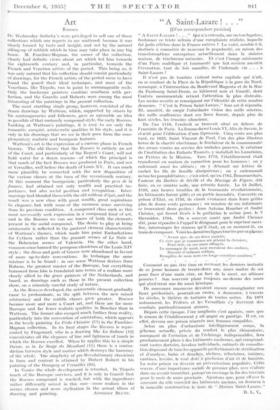Art
Rococo Os Wednesday Sotheby's were privileged to sell one of those collections which one regrets to see scattered, bedause it was clearly forMed by taste and insight, and not by the natural silting-up of rubbish which in time may take place in any big lionie M.. Fauchier-Magnan, the owner of the collection, clearly had definite views abbut art which led him towards the eighteenth century and, in particular, towards the French and Venetian artists of the period. This being so, it . was only natural that his collection should consist particularly Of drawings, for the French artists of the period seem to have found the pencil . their ideal technique, and most of the Venetians, like Tiepolo, run in paint to unmanageable scale: Only the landscape painters combine smallness with per- fection, and the Guardis and Roberts were among the most interesting of the paintings in the present collection.
The most startling single group, however, consisted of the dozen drawings by Watteau, which, supported by others by his contemporaries and followers, gave as agreeable an idea as possible of that curiously conipound style, the early RoCOco. Looking at Watteau's paintings, it is easy to see only the romantic, escapist, aristocratic qualities in his style, and it is Only in his drawings that we see in their pure form the com- plementary realistic and bourgeois features.
' Watteau's art is the expression of a Curious phase in French history. The 'old theory that the Rococo is entirely an• art of the Court, and particularly of the Regent's Court,' will not hold water for a dozen reasons—of which the prineipal is that much.of the best Rococo was produced in Paris, and not at Versailles, well before the death of Louis XV. It can much more plaugibly be connected with the new disposition' of the Various classes at the turn of the seventeenth century: At this moment the bourgeoisie,' particularly the gene de la finance, had attained not only wealth and practical im- portance, but also social position and recognition. Inter- marriage had blended them with the old noblesse d'epee, and the result was a new clasS with great wealth, great aspirations to elegance, but with some of the common sense surviving from its previous condition. A compound class such as this must necessarily seek expression in a compound kind of art, and in the Rococo we can see traces of both the elements present in the social compound. The desire to play at being aristocratic is reflected in the pastoral element characteristic of Watteau's themes, which made him paint Embarkations for Cythera rather than the peasant scenes of Le Nain or the Bohemian scenes of Valentin. On the other hand, common sense banned the pompous'c4assicism of the Louis XIV style ; the dress and gods of Greece were abandoned in favour of more up-to-date 'conventions.. In technique the same mixture is to be found : in one sense Watteau derives from Rubens, the greatest master of the Baroque, but everything borrowed from him is translated into terms of a realism more closely allied to the genre painters of the 'Netherlands, and based, as drawings such as those in the present collection show, on a minutely careful study of nature.
., As the developed, the aristocratic element gradually came to predominate, as the split between the new mixed aristocracy and the middle classes grew greater. Rococo became more and more a Court art, and there arc far more Baroque and far fewer realistic qualities in Boucher than in VVatteati. The former also escaped much further from reality, particularly into the convention of orientalism, which appears in the lovely painting La Peelle Ckinoise (77) in theFauchier-. Magnan collection. In its final stages the Rococo is repre- sented by Fragonard, who in a drawing like La Sidtane (12) concentrates all the elegance of line and lightness of touch in which the Rococo excelled: When he applies this to nsiniple theme, as in. Le Songe 'Men diant, (11) there is it contra- diction between Style and matter which destroys the hannony of the Whole. 'I he simplicity of pre-ReVolutionary classicism in form and' content is attained by Hubert Robert in his painting of the Orangery at Versailles (92).
. In Venice the whole development is retarded. In Tiepolo much of the Baroque survives, and it is only in Guardi that the Rococo compound is reached, but with' the ingredients rather differently mixed in this case—more realism in the scenes chosen and more stylisation in the actual idiom of












































 Previous page
Previous page